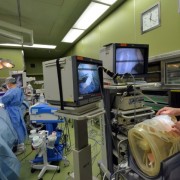Polymer gel can instantly stop bleeding
Medical gel can instantly stop bleeding
Joe Landolina starts his TED Talk, This gel can make you stop bleeding instantly, with a battleground scenario. When a soldier has a bleeding wound immediate attention is required but does not always arrive immediately. Landolina tells us that this problem is not just a part of war, but is present in many different medical situations.
Joe does most of his research in smart biomaterials. The goal is to find materials that will work naturally with the body’s systems, helping the body to heal. His research focused on the extracellular matrix that exists as a mesh. The mesh houses cells, gives them direction and tells them how to behave.
The extracellular matrix is different in every part of the body, posing a difficulty for a healing solution that can be of service everywhere. Cutting the body requires the extracellular matrix to reform, and he says that a scar is poorly formed matrix.
Landolina found a novel approach to healing by treating each matrix as a three dimensional problem. Small pieces of plant based polymer can be reassembled into wounds, and will reassemble into local tissue and mimic its properties. The blood recognizes the gel and creates a fiber that begins the clotting process.
A demonstration is shown on the screen, simulating an arterial bleed at twice the normal pressure. An estimate is given that a wound like this would take five minutes to heal when pressure is placed on the affected area. The gel is pushed into the cut and stops the bleeding right away.
Veterinarians should have this technology on hand by January 2015 and Landolina hopes that at some point in 2015 it will be approved for human use. Joe’s company Suneris is marketing the product as VETIGEL.
Having this on hand for soldiers or medical professionals would be a huge win for healing. Normal concerns involving packaging, distribution, testing and implementation exist but the potential is huge.
Source TED






Leave a Reply
Want to join the discussion?Feel free to contribute!